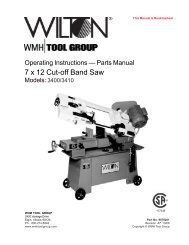Caution: This document contains mixed page sizes ... - Igor Chudov
Caution: This document contains mixed page sizes ... - Igor Chudov
Caution: This document contains mixed page sizes ... - Igor Chudov
Create successful ePaper yourself
Turn your PDF publications into a flip-book with our unique Google optimized e-Paper software.
The winding schematic (Figure 25) shows the resist-<br />
ance values for the individual coils in ohms. Resist-<br />
ance between any primary and secondary leads and<br />
from any lead to transformer frameshould be infinity.<br />
vR21-9<br />
m<br />
531-649 OHMS Tzl<br />
x2<br />
x1<br />
vR21-10<br />
FIGURE 25. T21 WINDING SCHEMATIC<br />
. .<br />
VR21 REPLACEMENT<br />
Usethe following procedure for replacing the voltage<br />
regulator PC board or VI? chassis.<br />
1. Stop engine.<br />
2. Disconnect and if necessary, label wires: VR21-1<br />
through VR21-12 Refer to AC control wiring<br />
diagram.<br />
3. Remove four screws at corners.<br />
4. Remove old PC board.<br />
5. Install new PC board; secure with four screws.<br />
6. Reconnect wires removed in step 2 at proper<br />
terminals.<br />
7. Place jumper W12 at proper terminals for your<br />
particular voltage code and voltage connection.<br />
See Test Procedure [Q].<br />
8. Perform voltage calibration and stability adjustment<br />
procedures to obtain the correct generator<br />
output voltageand stability with new PC board in<br />
set.<br />
TESTING ROTATING RECTIFIERS ’<br />
Two different rectifier assemblies make up the rotat-<br />
28<br />
ing rectifier bridge assembly, Figure 26. Using an<br />
accurate ohmmeter, test each CR using negative and<br />
positive polarities. Test rectifiers as follows:<br />
1. Disconnect all leads from assembly to be tested.<br />
2. Connect one test lead to F1+ stud and connect<br />
other lead to CRl, CR2, and CR3 in turn; record<br />
resistance value of each rectifier.<br />
3. Connect one lead to F2- stud and connect other<br />
lead to CR3, CR4 and CR5 in turn; record resistance<br />
value of each rectifier.<br />
4. Reverse ohmmeter leads from step 2 and record<br />
resistance value of each rectifier F1+ to CRl,,<br />
CR2, and CR3 and F2- to CR4, CR5, and CR6.<br />
5. All three resistance readings should be high in<br />
one tedand low in the other test. If any reading is<br />
high or low in both tests, rectifier assembly is<br />
. . defe,ctive.<br />
6. Replace defective rectifier assembly with new,<br />
identical part.<br />
Use 24ibr-h. (2.7 Nom) torquewhen replacing nutsof Fl+and F2-,<br />
CRl, CR2, CR3, CR4, CRS, and CR6.<br />
CR3<br />
FIGURE 26. TESTING ROTATING RECTIFIERS<br />
[HI<br />
TESTING EXCITER STATOR<br />
Test the exciter stator (Figure 27) for open or shorted<br />
windings and grounds as follows:<br />
Testing for Open or Shorted Windings:<br />
Disconnect F1+ and F2- exciter field leads from ter-<br />
minal block in generator end bell. The resistance<br />
between field leads should be 13.05 to 15.95 ohms at<br />
77’ F (25OC).<br />
Testing for Grounds:<br />
Connect ohmmeter between either field lead and<br />
exciter stator laminations. Use ohmmeter set at RX<br />
100 scale. An ohmmeter reading of less than infinity<br />
( Di ) indicates defective ground insulation.<br />
c<br />
1<br />
-
















